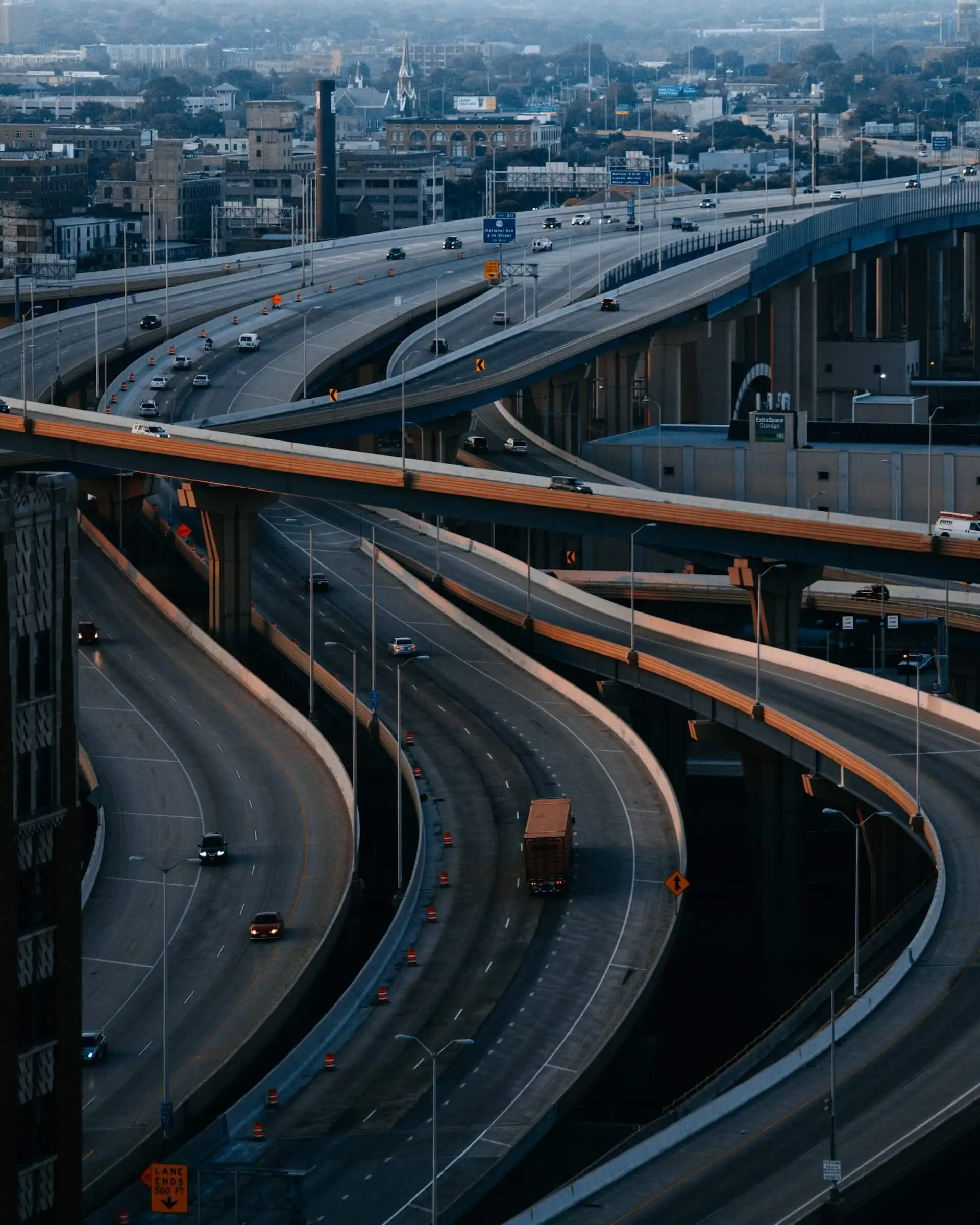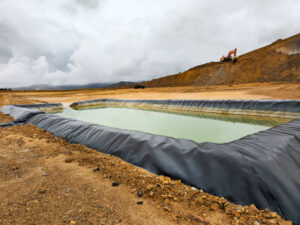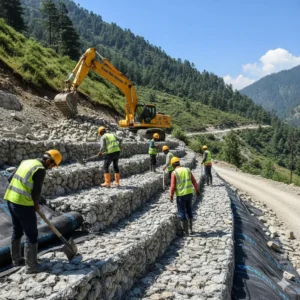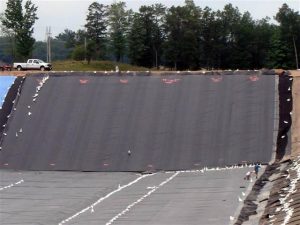Mountain Engineering in Srinagar: A Case Study on Slope Stability Using Ocean Hexagonal Woven Double Twisted Gabion Boxes
Introduction
Mountainous terrains pose some of the toughest challenges for civil and geotechnical engineers. From slope instability to erosion control, every project in such regions demands advanced engineering solutions that balance safety, sustainability, and cost efficiency. The Himalayan region, particularly around Srinagar (Jammu & Kashmir), is highly prone to landslides and soil erosion due to steep slopes, fragile geology, and high precipitation rates.
To mitigate these challenges, Ocean Non Wovens was entrusted with supplying and installing 1,000 units of Ocean Hexagonal Woven Double Twisted Gabion Boxes for a major Mountain Engineering project in Srinagar. This case study highlights the project objectives, the engineering approach adopted, the performance of gabion technology, and its role in long-term mountain stabilization.
Understanding Mountain Engineering and Its Challenges
Mountain engineering refers to the design, construction, and maintenance of infrastructure in mountainous regions, integrating geotechnical stability, environmental preservation, and hydrological balance. According to the Indian Road Congress (IRC: SP: 48-1998), over 60% of slope failures in hilly terrains are caused by water-induced erosion and unstable soil masses [1].
Key challenges in mountain engineering include:
- Soil erosion and slope instability due to rainfall and snowmelt.
- Retaining wall failures caused by hydrostatic pressure.
- Limited access to heavy machinery in steep terrain.
- Environmental restrictions due to ecological sensitivity.
Hence, the solutions adopted must be lightweight, flexible, and environmentally friendly, while still maintaining structural durability — a perfect scenario for the use of gabion structures.
Project Overview: Srinagar Mountain Stabilization Work
- Location: Srinagar, Jammu & Kashmir, India
- Project Type: Mountain slope stabilization and erosion control
- Product Used: Ocean Hexagonal Woven Double Twisted Gabion Box
- Quantity Supplied: 1,000 Boxes
- Objective: To prevent slope failure, protect the base of the mountain road, and reduce erosion risks near the settlement zones.
The project area was located along a steep section of the Srinagar highway corridor, which frequently experienced slope slips and minor landslides during the monsoon season. Traditional masonry retaining walls in the region had shown signs of distress due to poor drainage and rigid structure design.
Why Gabion Structures Were Chosen
Gabion structures — particularly double twisted hexagonal woven boxes — have become a preferred solution for mountain engineering projects globally. Their flexibility, permeability, and mechanical stability allow them to perform effectively under high-stress and variable terrain conditions.
Key advantages include:
- Flexibility: Gabion boxes can deform slightly without losing structural integrity, crucial in dynamic mountain terrains [2].
- Permeability: Allows free drainage, minimizing hydrostatic pressure behind retaining walls.
- Eco-friendliness: Promotes vegetation growth over time, stabilizing the slope naturally.
- Ease of Installation: Simple assembly using local manpower, reducing equipment and logistics costs.
In fact, research published by the Central Road Research Institute (CRRI) found that gabion walls in hilly terrains exhibit 30–40% better long-term performance compared to rigid RCC structures in high-moisture environments [3].
About Ocean Hexagonal Woven Double Twisted Gabion Box
The Ocean Hexagonal Woven Double Twisted Gabion Box is a premium geotechnical solution designed for durability and strength in harsh terrain. Manufactured from galvanized or PVC-coated steel wire, these gabions feature double twisting technology that prevents unraveling even when cut or damaged locally — a critical factor for mountain stability.
Technical Specifications:
- Mesh Type: Hexagonal (Double Twisted)
- Mesh Opening: 60 × 80 mm / 80 × 100 mm (as per design requirement)
- Wire Diameter: 2.7–3.4 mm (galvanized or PVC coated)
- Tensile Strength: ≥ 380 N/mm² (as per ASTM A641 and EN 10223-3 standards)
- Coating Life: Minimum 10–12 years in exposed conditions with PVC protection
Applications:
- Slope protection and erosion control
- Retaining wall construction
- Riverbank and streambed stabilization
- Road and embankment protection
In this Srinagar project, gabion boxes were filled with locally sourced angular stones, providing interlocking friction and self-weight stability to resist soil and rock movement.
Implementation Strategy
- Site Preparation:
The unstable slope was cleared of debris, vegetation, and loose soil. Drainage channels were created to redirect surface runoff. - Foundation Layer:
A geotextile separator layer was placed beneath the gabion foundation to prevent soil migration and improve drainage. (Ocean Non Wovens Geotextile was also used in some segments for added filtration.) - Gabion Assembly & Placement:
The Ocean Gabion Boxes were assembled onsite using lacing wire and securely tied together to form a continuous retaining structure. - Stone Filling:
Locally quarried stones (100–200 mm) were filled in layers to ensure compactness and minimize voids. - Vegetative Layer:
Top gabion layers were designed with soil pockets to encourage natural vegetation growth, promoting long-term bio-stabilization.
Performance and Outcomes
After completion, the structure demonstrated excellent drainage capacity and flexibility during the 2024 monsoon season, when Srinagar recorded over 1,200 mm of rainfall [4]. The slopes remained stable, with no signs of bulging or soil washout.
- Reduced slope erosion by approximately 85% (observed through post-project site inspections).
- Improved road safety by preventing minor rockfalls and debris accumulation.
- Lower maintenance costs, as gabions require minimal upkeep compared to RCC structures.
The natural vegetation growth over the gabions also enhanced the aesthetic and ecological balance of the site — a benefit often overlooked in typical engineering reports.
What Most Companies Don’t Talk About: Microclimate and Thermal Benefits
One lesser-known advantage of gabion installations in mountainous terrain is their impact on microclimate regulation. The void-filled stone structure allows air circulation, reducing localized humidity and preventing freeze-thaw damage in colder months.
Moreover, the thermal inertia of stone-filled gabions helps stabilize temperature fluctuations at the slope surface — a factor critical in Himalayan regions where daytime and nighttime temperature variations can exceed 20°C. These subtle but significant benefits contribute to long-term structural resilience.
Environmental and Economic Impact
Using locally available stones for gabion filling reduced carbon emissions from transportation. Unlike concrete retaining walls, gabion systems have a low embodied carbon footprint and can be installed with minimal machinery, reducing ecological disruption.
According to the Indian Institute of Technology (IIT Roorkee), the life-cycle cost of gabion retaining walls is nearly 35% lower than conventional RCC retaining structures in hilly terrains [5].
Conclusion: Building Sustainable Mountain Solutions with Ocean Non Wovens
This Mountain Engineering project in Srinagar showcases how innovative geosynthetic solutions like Ocean Hexagonal Woven Double Twisted Gabion Boxes can redefine slope stability and erosion control in challenging mountain environments. The project not only strengthened the hillside but also ensured environmental harmony and long-term durability.
At Ocean Non Wovens, we specialize in designing and manufacturing high-performance geosynthetic products — from gabions and geotextiles to HDPE liners and geogrids — tailored for India’s diverse infrastructural challenges. Our commitment lies in delivering engineered solutions that stand the test of time and terrain.
If your next project involves slope stabilization, erosion control, or mountain infrastructure development, partner with Ocean Non Wovens — where engineering meets endurance.



